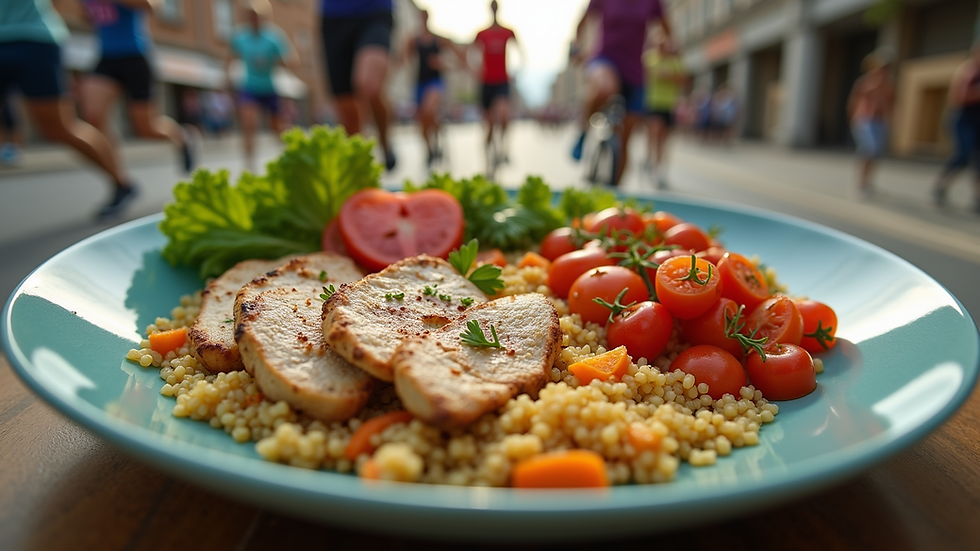Boosting Athletic Performance with Nutrition
- Rob Lawrie
- Sep 8
- 4 min read
When it comes to pushing your limits in endurance sports, nutrition is your secret weapon. You might be clocking miles on your bike or pounding the pavement for hours, but without the right fuel, your body won’t perform at its best. I’ve learned that what you eat before, during, and after your workouts can make a huge difference. So, let’s dive into some practical performance nutrition tips that can help you power through your training and races.
Why Performance Nutrition Tips Matter
Ever felt drained halfway through a long ride or run? That’s your body waving a red flag, asking for better fuel. Performance nutrition isn’t just about eating healthy; it’s about eating smart. It’s about timing your meals, choosing the right nutrients, and staying hydrated. Think of your body as a high-performance engine. Would you put cheap fuel in a sports car? No way! The same goes for your body.
Here’s what I focus on:
Carbohydrates for energy
Proteins for muscle repair
Fats for sustained fuel
Hydration to keep everything running smoothly
Getting these right can help you avoid hitting the dreaded wall and keep your energy steady.

Fueling up with the right energy gels during a ride
Top Performance Nutrition Tips for Endurance Athletes
Let’s get into the nitty-gritty. What should you eat and when? Here are some of my go-to tips that have helped me and many others boost endurance and recovery.
1. Pre-Workout Fuel
About 2-3 hours before your session, eat a meal rich in complex carbs and moderate protein. Think oatmeal with banana and a spoon of peanut butter or wholegrain toast with eggs. This combo gives you slow-releasing energy and keeps hunger at bay.
If you’re short on time, a small snack like a banana or an energy bar 30-60 minutes before can work wonders.
2. During Workout Nutrition
For sessions longer than 90 minutes, your body needs quick energy. That’s where carbs come in again. Sports drinks, gels, or chews are perfect because they’re easy to digest and absorb fast.
Don’t forget hydration! Sip water regularly, and if it’s hot or you’re sweating buckets, opt for electrolyte drinks to replace lost salts.
3. Post-Workout Recovery
After training, your muscles are like sponges, ready to soak up nutrients. Aim to eat within 30-60 minutes. A mix of carbs and protein is key here. Chocolate milk, a smoothie with whey protein and fruit, or a chicken and rice bowl are excellent choices.
This helps repair muscle damage and replenish glycogen stores, so you’re ready for the next session.
4. Daily Nutrition Habits
Consistency is king. Eating balanced meals throughout the day supports your training and recovery. Include plenty of vegetables, lean proteins, whole grains, and healthy fats. Don’t skimp on calories either - endurance training burns a lot!
5. Experiment and Personalise
Everyone’s body reacts differently. What works for me might not work for you. Try different foods and timing strategies during training, not on race day. Keep a nutrition diary to track what fuels you best.

Balanced meals support sustained energy and recovery
Is Athlete Performance Solutions Legit?
You might have come across various products and supplements claiming to boost your athletic performance. It’s natural to wonder if they’re worth your time and money. From my experience and research, it’s crucial to choose brands that are transparent about their ingredients and backed by science.
Athlete Performance Solutions offers a range of products designed specifically for endurance athletes. Their focus on quality and affordability makes them a solid option. Plus, they provide clear guidance on how to use their products effectively.
Before trying any new supplement, always check for:
Third-party testing
Clear ingredient lists
Positive user reviews
Alignment with your nutrition goals
Remember, no supplement replaces a solid nutrition foundation. They should complement your diet, not replace it.
How to Incorporate Athletic Performance Enhancement into Your Routine
If you’re serious about taking your training to the next level, consider integrating athletic performance enhancement strategies into your nutrition plan. This means not just eating well but using targeted products and timing your intake to maximise results.
Here’s how I do it:
Plan your meals and snacks around your training schedule.
Use endurance-specific fuels during long sessions.
Prioritise recovery nutrition immediately after workouts.
Stay consistent with hydration and electrolyte balance.
Monitor your progress and adjust as needed.
By treating nutrition as part of your training, you’ll notice better stamina, faster recovery, and improved overall performance.

Essential nutrition and hydration gear for endurance training
Fuel Your Journey and Enjoy the Ride
Nutrition isn’t just about performance; it’s about enjoying the journey. When you fuel your body right, you feel stronger, more energetic, and more motivated. It’s like giving yourself a little boost every day.
Remember, the goal is to find what works for you and stick with it. Don’t get overwhelmed by all the options out there. Start simple, focus on whole foods, and add in specialised products as needed.
If you want to explore more about how to fuel your endurance efforts effectively, check out FTP Endurance Fuel. They’re passionate about helping athletes like you find affordable, mess-free nutrition solutions that fit your lifestyle.
Keep pushing, keep fuelling, and most importantly, keep enjoying every step, pedal, and stroke of your athletic journey!








Comments